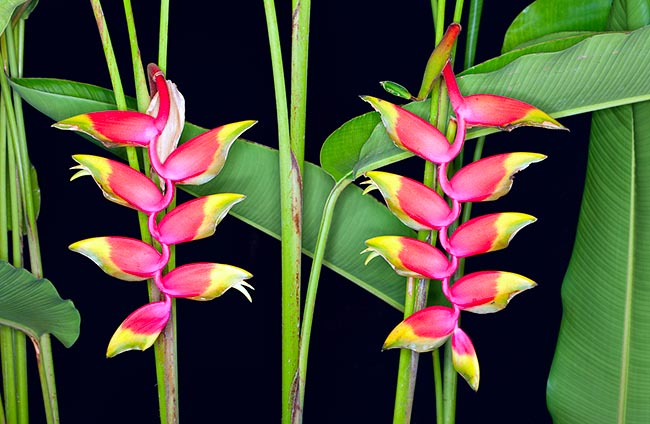Family : Heliconiaceae

Text © Pietro Puccio

English translation by Mario Beltramini
Heliconia rostrata can be 5 m tall with 80 cm inflorescences © Giuseppe Mazza
The name of the genus comes from the Latin “Heliconius, a, um” = of the Helicon, mountain sacred to Apollo and to the Muses in the Greek mythology; the name of the species is the Latin adjective “rostratus, a, um” = equipped with rostrum, with the reference to the parrot beak-shaped (rostrum) bracts.
Common names: crab claw, hanging lobster-claws, hanging parrot’s beak, lobster claw, parrot’s beak heliconia (English); heliconia rostré, pince de homard (French); bananeira do brejo, bananeira ornamental (Portuguese-Brazil); patujú, platanillo (Spanish).
The Heliconia rostrata Ruiz & Pav. (1802) is an evergreen perennial rhizomatous erect herbaceous species quickly forming 1-5 m tall dense tufts.
The leaves, on a 20-30 cm long petiole, are basal, alternate, simple, entire, oblong with brusquely pointed apex and prominent central nervation in the lower page, 0,4-1,2 m long and 10-20 cm broad, of intense green colour above, paler below, and sheathing tubular foliar bases forming a 50-90 cm long pseudo-stem.
The inflorescence, on a robust peduncle, is a 30-80 cm long drooping terminal spike with markedly waved red rachis and 10-40 alternate bracts with the concavity looking downwards, distichous, imbricate, coriaceous, pointed, reminding due to their shape the beak of a parrot, of bright red colour with cream or yellow apex and green margins, 6-15 cm long.
The bracts enclose up to 18 tubular, 3,5-4,5 cm long flowers, white at the base pale yellow at the apex, rich of nectar.
The flowers, with bilateral symmetry, are hermaphroditic, with 3 sepals, two of which merged and one free, and three petals fused together, little differentiated between them, 5 fertile stamina and one staminode opposite to the free sepal; the flowers are pollinated by the humming birds. The fruits are globose drupes initially green, then glossy dark blue when ripe, containing 1-3 seeds.
It reproduces by seed, previously scarified and kept in water for 4 days to soften the tegument, in organic loam with addition of siliceous sand or agri-perlite for a 30%, maintained humid at the temperature of 26-28 °C, with times of germination variable from one to six months or more, and first flowering after 3-4 years, but usually and easily by division of the rhizomes in spring, with each section provided with several vegetative buds.

A dwarf variety, used as cut flower, suitable to small tropical gardens © Giuseppe Mazza
Successfully cultivable also in pot, in particular the varieties with reduced form, to be sheltered in greenhouses, verandas or luminous winter gardens, where the climate conditions do not allow its permanence in open air during the coldest months, utilizing an organic substratum with addition of siliceous sand or perlite for a 30% to improve the drainage, with high ambient humidity, winter day temperatures of 20-24 °C and lowest night ones not under the 15 °C, lower temperatures would slow down the vegetation and may hinder the blooming. The watering must be regular and abundant in summer, avoiding the stagnations, cause of easy rottenness, more spaced in winter, letting the substratum to partially dry up before giving water again, with fertilizations done preferably with slow-release balanced products with addition of microelements.
It is easily subject to mites and bug meals attacks, to be treated, in case of serious infestation, with specific products. The cut inflorescences, of great ornamental effect and long lasting, about 2 weeks, are often utilized in the floral compositions.
Synonyms: Heliconia poeppigiana Eichler ex Petersen (1890); Bihai poeppigiana (Eichler ex Petersen) Kuntze (1891); Bihai rostrata (Ruiz & Pav.) Griggs (1904).
